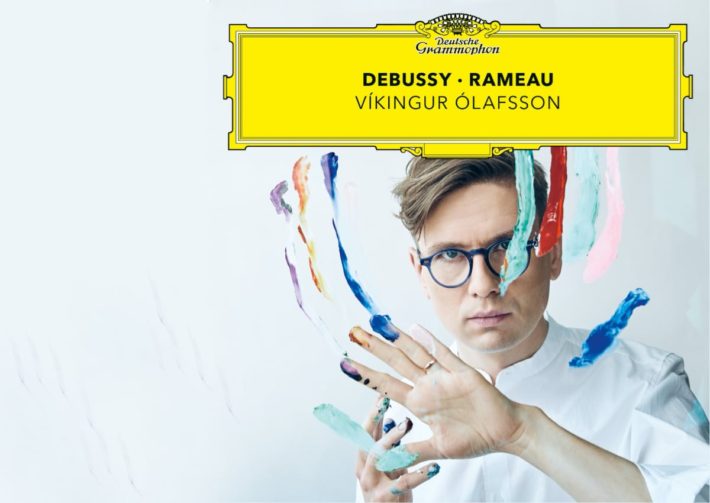What sets Víkingur Ólafsson apart from many pianists is not only his formidable technique, but his artistry and vision to create a journey. In his previous DG releases, he focused on a single composer — Philip Glass and Johann Sebastian Bach. This time he programs an album of two composers – Debussy and Rameau.
For anyone expecting their Debussy to sound like the masters in this repertoire (Jean-Efflam Bavouzet, Jean-Yves Thibaudet or Pascal Rogé, to name just a few), expectations will be dashed. Ólafsson has a sound all of his own, bringing a refreshing clarity to the mellifluous and mysterious sounds of impressionism. Opening with Debussy’s “Prélude from La Damoiselle élue”, Ólafsson brings transparency of sound and pristine clarity to the right-hand, while chords are voiced with such musicality, long phrases extend with elegance and beauty. Without pausing for breath, he launches into Rameau’s “Le Rappel des Oiseaux”. The juxtaposition of these two contrasting musical worlds feels seamless, as textures of the Rameau complement and contrast with the Debussy. Precision of articulation is impressive, ornaments are tightly executed, but there are freedom and spirit that bring this music to life.
A sequence of dances and other pieces follow from Rameau’s “Pièces de Clavecin” (1724). These introspective miniatures intrigue and inspire the imagination with a divergence of texture, color, tempo, and mood. Ólafsson relishes the character of the music, bringing both authority and spontaneity. He captures the pastoral nature of “Mussette en Rodeau”, the vigour of “Tambourin” and the wit, as well as the charm, of “La Villageoise” (tracks 4-6). Alexandre Tharaud’s recent album, “Versailles” (reviewed here), contains a selection of Rameau pieces programmed by Ólafsson. Comparatively, Tharaud takes a very different approach to Ólafsson. He treats the music with a more serious intent, articulation is fussier, ornaments increasingly varied and the tonal palette is darker. Both pianists offer equally valid interpretations.
Related Classical Music Reviews
- Review: “Versailles” – Alexandre Tharaud, Piano
- Review: César Franck – Piano Works – Nikolai Lugansky
- Review: Ravel – Piano Concerto, Le Tombeau de Couperin – Perianes, Pons
Returning to a sequence of three Debussy pieces — “Jardins sous la pluie” from “Estampes”, “Serenade for the doll” and “Snow is dancing” from “Children’s Corner” – Ólafsson reveals a freshness which focusses on the narrative. The distinctive aspects of Debussy’s style are very much appreciable, but played with a vibrancy that creates a striking picture in the mind’s eye. Three Debussy Préludes, chosen from books one and two, are interspersed throughout the Rameau in the second half of the album. Rameau’s “The Arts and The Hours” (in Ólafsson’s own arrangement, track 17) leads into “La Fille aux Cheveux de Lin” (Prelude 8 from book 1). In the Rameau, the beauty of the long melodic lines, along with their antiphony, flow effortlessly. Ólafsson continues this approach into this all-too-familiar Debussy piece, in which he brings tenderness and spontaneity. If Ondine had magical powers, Ólafsson has musical ones in the imagery he creates with his fingers, in his dramatic execution of the prelude by the same name, from the second book of préludes.
A highly engaging and considered sequence of Rameau’s more popular keyboard pieces leads to the final piece of Debussy. These works include “La Poule” and “Les Savages”. “Homage à Rameau”, appropriately set as the closing work of this recital, is delivered without sentimentality or cliché, the final bars effectively return us back almost full circle to where we began 70 minutes ago. As a sense of melancholia engulfs and silence falls, the musical world at the end of this journey feels changed.
The journey Ólafsson travels is remarkable for its perspectives, each piece offers a different vista into the two composers while drawing a wide-ranging knowledge from each composition. His highly individual readings are nothing short of commanding. The choice of instrument is very personal to Ólafsson, as this is the Steinway he chose for the Harpa Concert Hall, Reykjavik, in which this album (and his previous two) were recorded. The piano is close, but the Deutsche Grammophon engineers have captured more of the acoustic on this occasion, which is welcomed. If coming to Ólafsson for the first time, this album will undoubtedly delight; for Ólafsson devotees this will sit proudly amongst his other groundbreaking releases.

“Debbusy – Rameau“
Vikingur Ólafsson, Piano
Deutsche Grammophon, CD 4837701, Vinyl 4838283
Albums Mentioned In This Review
Read more classical music reviews or visit The Classic Review Amazon store
Follow Us and Comment:
Get our periodic classical music newsletter with our recent reviews, news and beginners guides.
We respect your privacy.









